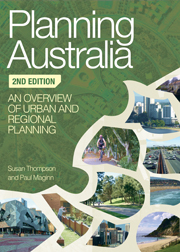Book contents
- Frontmatter
- Contents
- Contributors
- Figures and tables
- Discussion points and case studies
- Preface
- Acknowledgments
- Abbreviations
- Table of statutes
- Introduction
- Part I Frameworks
- Part II Key Issues
- 6 Planning and the natural environment
- 7 The metropolis
- 8 Planning for rural landscapes
- 9 Planning for regions
- 10 Planning for diverse communities
- 11 Aboriginal and Torres Strait Islander Australians
- 12 Community participation in planning
- 13 Urban design
- 14 Planning for heritage conservation and management
- 15 Transport planning
- 16 Healthy planning
- Conclusion: planning Australia into the future
- Index
- References
15 - Transport planning
from Part II - Key Issues
- Frontmatter
- Contents
- Contributors
- Figures and tables
- Discussion points and case studies
- Preface
- Acknowledgments
- Abbreviations
- Table of statutes
- Introduction
- Part I Frameworks
- Part II Key Issues
- 6 Planning and the natural environment
- 7 The metropolis
- 8 Planning for rural landscapes
- 9 Planning for regions
- 10 Planning for diverse communities
- 11 Aboriginal and Torres Strait Islander Australians
- 12 Community participation in planning
- 13 Urban design
- 14 Planning for heritage conservation and management
- 15 Transport planning
- 16 Healthy planning
- Conclusion: planning Australia into the future
- Index
- References
Summary
Key terms: transport planning; accessibility; systems approach; predict and provide; peak oil; congestion charging; compact city; urban form; transit-oriented development; integrated planning; public transport; para-transit; network planning; active transport.
Transport has always been central to the planning of cities and regions. The Griffin Plan for Canberra, for example, used streets and intersections to structure the city (see Chapters 4 and 13). Similarly, Ebenezer Howard’s (1902) ‘garden city’ was designed to reduce long travel times to and from work. Despite this history, 21st-century transport planners are still grappling with the problem of long work journeys in the wake of suburban expansion, as well as dealing with a suite of new challenges: from congestion, pollution and climate change, to more personal concerns of obesity and lack of exercise (see Chapter 16).
This chapter begins by discussing the scope of transport planning, distinguishing it from related disciplines such as traffic engineering. It then examines the development of transport planning techniques and ideas in the United States and Europe, and their adoption by Australian planners. This leads to an analysis of contemporary challenges and policy responses, before concluding with a discussion of likely future directions in transport planning.
- Type
- Chapter
- Information
- Planning AustraliaAn Overview of Urban and Regional Planning, pp. 357 - 380Publisher: Cambridge University PressPrint publication year: 2012
References
- 1
- Cited by



